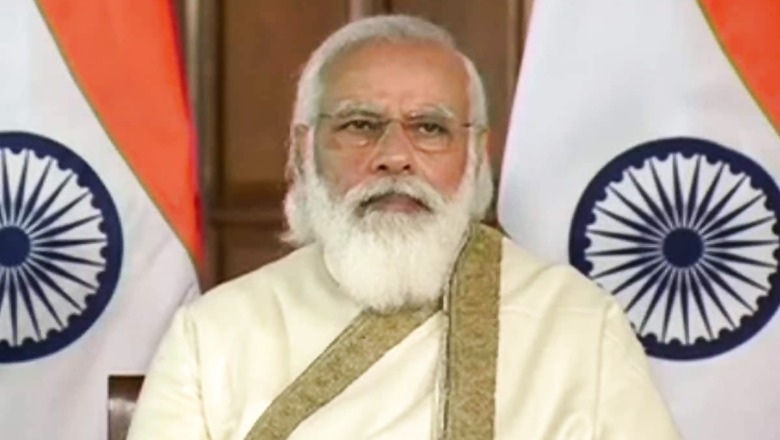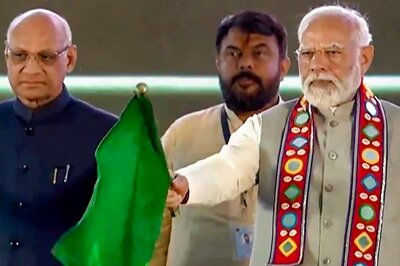
views
Something is up. It’s hardly likely that the Prime Minister would make two speeches about privatisation and getting the government out of the business of business without meaning it. One of the biggest disappointments of Narendra Modi’s first tenure as the Prime Minister was that after introducing a slew of structural reforms within the first six months of 2014, almost all of those were put on hold following Rahul Gandhi’s “suit-boot” jibe.
Noticeably, this isn’t the first time the Prime Minister has spoken of getting the government out of business. Almost all through 2013, when it was still uncertain that he would be the prime ministerial candidate, he went on saying things that were music to investor ears, including his trademark phrase “more governance, less government”. This was then expanded to, “The government is omnipresent in India. Still governance is lacking which results in people losing faith in the institution. God is omnipresent, and people have faith in god. Why? It is because god doesn’t discriminate, but the government does”. However, with the benefit of hindsight, much of this seemed merely to posit a sharp difference between him and Rahul Gandhi, whose entire campaign was swinging around the promise of sops, handouts and patronage. That is probably why Modi said that the root cause of the problems lay in the fact that the “system treated the common man as the seeker and itself as the provider”.
Is there a pattern?
However, as a particularly astute friend had pointed out, during his stint as Gujarat’s Chief Minister, the entire first term was spent winning a second term, and that all the reforms had come in the second term. This is where the pieces are slowly adding up. Last year, in the midst of Covid-19, the move was made on labour reforms, a particularly smart one given the contentiousness of the subject. This was accompanied by the revised education policy that discarded the old learn by rote methods in favour of problem-solving. Though they have been appreciated as standalones, their genius can be understood when you fuse them together. As we all know quality control in production is a factor of labour, the labour law de-regulated the market while the revised education policy laid the groundwork for human value addition and critical problem-solving skills for emerging labour.
Another leg of reforms can be seen in the broadsides being fired at the bureaucracy. It started with lateral hiring for the post of joint secretary. While as such these lateral hiring produced no particular improvement, with the benefit of hindsight we can see that this was the beginning of a pattern of warning the bureaucracy to mend its ways. Unsurprisingly, just before another round of lateral hiring was announced by Finance Minister Nirmala Sitharaman, the minister for roads and highways fired a sharp broadside at bureaucrats in a public conference. He hinted rather unsubtly at how alleged “incompetence” was usually a mask for corruption. While one may see it as coincidence that he was given additional charge of the MSME sector in 2019, it now seems unlikely that this was coincidence as true reforms are those that begin with MSMEs. This pattern was topped off by the Prime Minister himself coming out against bureaucrats.
ALSO READ| PM Modi’s Call for Asset Monetisation Signals Govt Commitment, Ball Now in Private Sector’s Court
Everything points to slow and systematic groundwork towards significant structural reforms and possibly significant privatisation as well. Prime Minister Modi in his speech on Wednesday made it abundantly clear he needed more money for basic human services as well as human value addition and the bottomless pit that were the PSUs were only getting in the way, absorbing precious resources that could be spent much more productively elsewhere.
Working on an India model
The question one then asks is, why this abundant caution? What exactly is he up against? Well, there are several issues that merit such caution. As privatisation in Russia following the collapse of the USSR has shown, haste combined with a notoriously corrupt bureaucracy and zero bureaucratic accountability, where corruption is disguised as incompetence, only benefits crony capitalists. In Russia, this virtually led to the creation of an oligarchy that dictated state actions and frequently foreign policy as well, completely contradictory to Russian national interests.
The second trend we see is the re-emergence of feudalism. Although the US did emerge from the “robber baron” phase to move towards true capitalism, today US tech oligarchs behave no better than their Russian counterparts—making or toppling presidents in the United States with absolute impunity while undermining state authority. Realistically, how much better is China? A China where over 70 per cent of demand remains public rather than private—used by the Communist Party as a means of controlling capitalists—is no model for India to follow. He seems quite clear then that an Indian model will be one where the private sector will be given freedoms but creation of oligarchies or meddling in the system will not be allowed.
Furthermore, as the current agricultural reforms and consequent riots have shown, the ability to bring life to standstill by status-quoists remains potent, as does their ability to influence the international narrative. What’s worse, courts have resorted to extreme overreach in suspending legislation passed by due process. Modi cannot afford to open too many fronts, all at the same time. The best generals pick their opponents one by one—never allowing them the opportunity to unite. Indeed, if you want proof of his Israeli military style “oblique attack” tactics, one only needs to look at how Article 370 was abrogated using SC/ST reservation in Kashmir as a Trojan horse months in prior.
The dilemma of privatisation in India then is—how does one privatise without the creation of corporate feudalism, without alienating all the people at the same time and without losing elections? If indeed one is an optimist, what we may be seeing is a slow multi-pronged attack whose scale and dimensions will only become obvious over time.
Read all the Latest News, Breaking News and Coronavirus News here



















Comments
0 comment